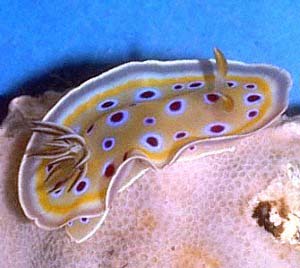
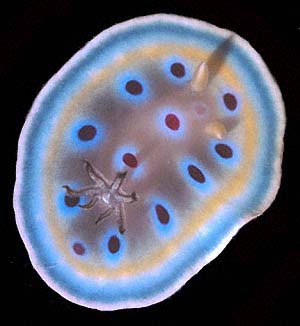
Chromodoris geminus
Rudman, 1987
Order: NUDIBRANCHIA
Suborder: DORIDINA
Family: Chromodorididae
DISTRIBUTION
Tropical Indian Ocean.
PHOTO
UPPER: Showing characteristic mantle wave where all the mantle edge is raised and lowered together, as in C. kuniei. Fungu Yasin, Dar es Salaam, Tanzania, November 1976, 35mm long alive. PHOTO: Bill Rudman.
LOWER: Phi Phi Is., Southern Thailand, 16m, December 1989. PHOTO: D.J.Brunckhorst.
This is one of a group of similarly coloured species which I have called the "Risbecia tryoni colour group". Other species include Risbecia tryoni, Chromodoris kuniei and Chromodoris leopardus. They all have large purple or purple-brown spots or marks, usually ringed with white, an often reticulate brownish background, and a purple border. Chromodoris geminus differs in having four colour bands around the mantle edge, an outermost white, then translucent greyish purple, then white, then yellow. The other three have a distinct purple line at the border, narrow in C. leopardus and R. tryoni, but broad in C. kuniei. The shape of the body of R. tryoni, high with a reduced mantle overlap, is typical of the genus Risbecia. The three species of Chromodoris have a wide mantle overlap. Of the three with the purple mantle edge, C. leopardus and C. kuniei can be distinguished from R. tryoni by the broad purple border, consisting of three slightly different coloured bands in C. kuniei, and by the leopard-like multiple spots, or marks, forming a hollow square, found in C. leopardus.
See also the recently described Chromodoris tritos, which may be a colour form of C. geminus and Chromodoris cf. geminus which has recently been reported from South Africa and has a very similar colour pattern.
References:
• Rudman, W.B. (1984) The Chromodorididae (Opisthobranchia: Mollusca) of the Indo-West Pacific: a review of the genera. Zoological Journal of the Linnean Society, 81: 115-273.
• Rudman, W.B. (1987) The Chromodorididae (Opisthobranchia: Mollusca) of the Indo-West Pacific: Chromodoris epicuria, C. aureopurpurea, C. annulata, C. coi and Risbecia tryoni colour groups. Zoological Journal of the Linnean Society, 90: 305-407.
Rudman, W.B., 1999 (January 22) Chromodoris geminus Rudman, 1987. [In] Sea Slug Forum. Australian Museum, Sydney. Available from http://www.seaslugforum.net/find/chrogemi
Related messages
Mantle flapping : Chromodoris geminus
September 10, 2009
From: Kamal El Tawil
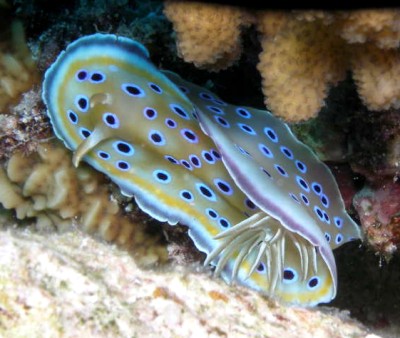
Dear Bill,
Re: Mantle flapping in Chromodoris geminus
I observed this Chromodoris geminus for about 15 minutes while it was continuously flapping its mantle in a rhythmic pattern while moving along the reef. I have seen many species crawl, but this one seemed to be crawling while flapping its mantle in a way like taking a step or leap forward. Again and again it continued to do so traveling a distance of about 50 centimetres until it disappeared under a rock.
Locality: White Rock, North of St. John's reef, 13 meters, Egypt, Red Sea, 7 July 2009, offshore reef. Length: 50 mms. Photographer: Kamal el Tawil.
Kindest regards,
Kamal
www.coralworld.net
kamal@coralworld.net
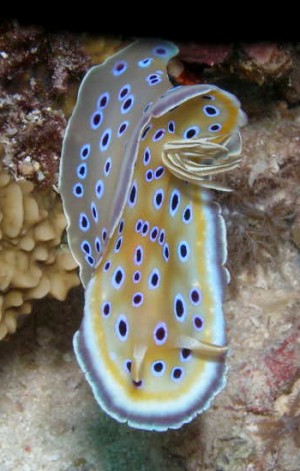
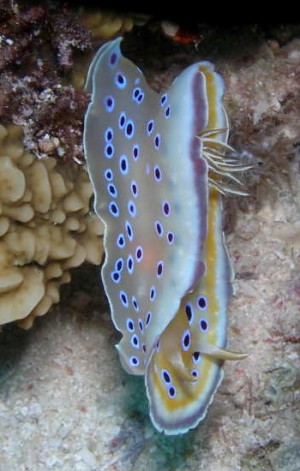
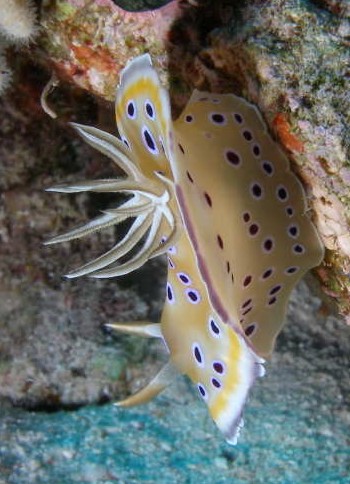
Thanks Kamal,
As I describe on the 'mantle-flapping' Fact Sheet, C. geminus is one of the species with the ability to raise and lower all its mantle edge at the same time. I am not sure if there is some evolutionary advantage to this, but for whatever reason it does it, it is certainly spectacular.
Some of your photos also show the mantle glands quite well. In this group of species, the glands are not very extensive, and in many animals are difficult to see, or may be temporarily absent or empty? As I have mentioned often, chromodorids have various types of glands or storage sacs where they accumulate distasteful chemicals from the sponges they feed on, to use in their own defence. You can see them as a few cream-white oval spots, around the mantle skirt, beneath the yellow band.
Best wishes,
Bill Rudman
Chromodoris geminus from Indonesia, Bali
October 14, 2008
From: Marcel Tanke
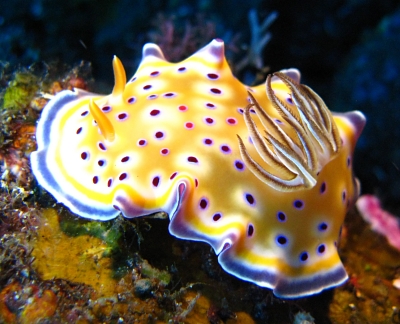
Concerning message #21633:
Dear Bill,
The Chromodoris geminus in the first picture has much smaller ocelli than the one in the second picture; or the ones shown on the C. geminus page on your forum. Please note also, a few red ocelli (first picture), that I also found in a some other C. geminus pictures on your forum.
Locality: Bali, Tulamben. Dive site Drop Off, 15, Indonesia, 29 September 2008, Reef on vulcanic rock. Length: 5 cm. Photographer: Marcel Tanke.
Best regards,
Marcel
MarcelTanke@cs.com
Tanke, M.A., 2008 (Oct 14) Chromodoris geminus from Indonesia, Bali. [Message in] Sea Slug Forum. Australian Museum, Sydney. Available from http://www.seaslugforum.net/find/21959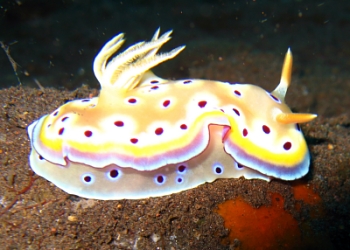
Dear Marcel,
Your mention od size and colour pof spots reminede me of an on-going discussion about this in Risbecia tryoni. Have a look at message #16573 and the earlier messages it refers to. Chromodoris kuniei also shows a considerable difference in size of spots [see message #5811]. I also vaguely remember discussing the possibility of dark purple or black spots turning the red as an artifact of artificial light - like 'red eye' in photos of people, but can't find that discussion.
Best wishes,
Bill Rudman
Re: Chromodoris geminus from the Red Sea
June 11, 2008
From: Joe De Vroe
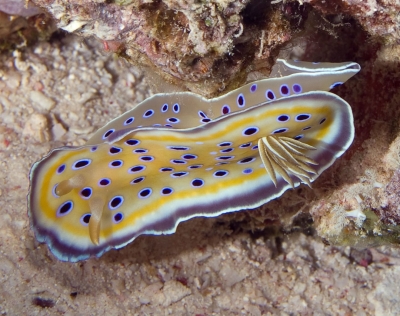
Concerning message #21626:
Dear Bill,
Here are some pictures for your collection ...
Locality: Umm Gamar, 14 m, Egypt, Red Sea, 08 May 2008, sandy. Length: 7 cm. Photographer: Joe De Vroe.
Regards,
Joe
joe.devroe@skynet.be
De Vroe, J., 2008 (Jun 11) Re: Chromodoris geminus from the Red Sea. [Message in] Sea Slug Forum. Australian Museum, Sydney. Available from http://www.seaslugforum.net/find/21633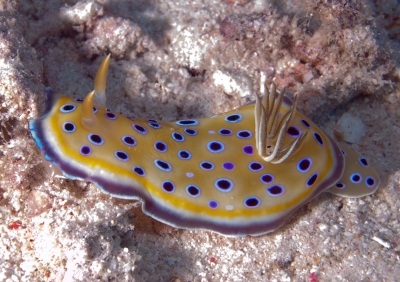
Thanks Joe,
A few more photos of this beautiful - but seldom seen - species will not go astray. I remember when I first found a specimen in Tanzania, I was so impressed I kept it alive in my laboratory for days and made everyone I saw come and have a look at it - before I sacrificed it for 'science'
Best wishes,
Bill Rudman
Chromodoris geminus from the Red Sea
June 5, 2008
From: Kamal El Tawil
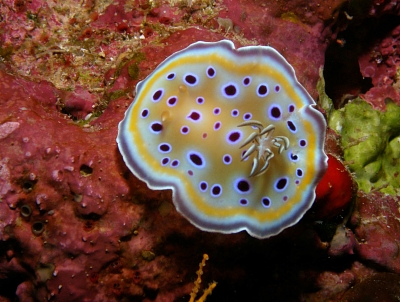
Concerning message #18575:
Dear Bill,
I found this Chromodoris geminus on a red sponge like background which is similar to the one on the oyster's shell in message #18575.
Possibly feeding on it ?
Locality: Elphinstone Reef, 17 metres, Egypt, Red Sea, 27 May 2008. Length: 50 mm. Photographer: Kamal El Tawil.
Best regards,
Kamal
www.coralworld.net
kamal@coralworld.net
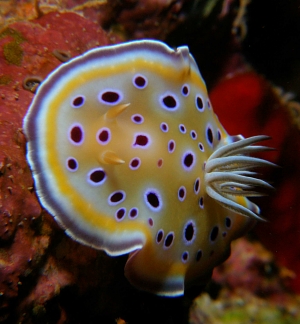
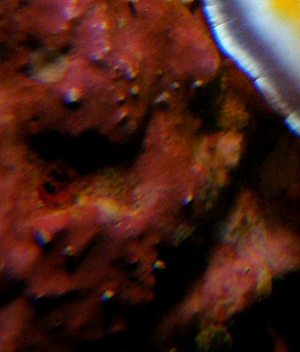
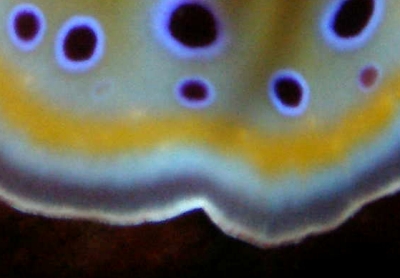
Dear Kamal,
Thanks for the photos. The pink-red background is a red algae which forms a calcareous layer over hard surfaces. They are often called 'coralline algae'. Close relatives form bushy plants but because they have a solid calcareous 'skin' the stalks or leaves are broken up into small segments - like a suit of armour- so they can move in the water current. The pink-red background in the earlier message is also calcareous red algae. I suspect C. geminus feeds on a dark blue to red-purple sponge called Chelonaplysilla violacea but I could be wrong. I have included a close-up [middle right photo] which seems to show some patches of a dark brownish purple sponge, which could be Chelonaplysilla, but it could also just be my imagination.
In the close-up [lower right photo ] there are a number of opaque whitish patches under the yellow band. These are most likely the mantle glands. In other species of Chromodoris these glands are usually more ramifying and usually close to the mantle edge, so it is possible that future research will show that this species, and a few others, should not remain in the genus Chromodoris.
Best wishes,
Bill Rudman
Chromodoris geminus from the Red Sea
July 4, 2007
From: Darja Tjioe
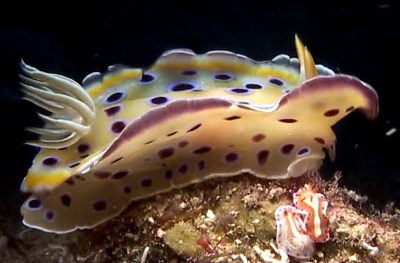
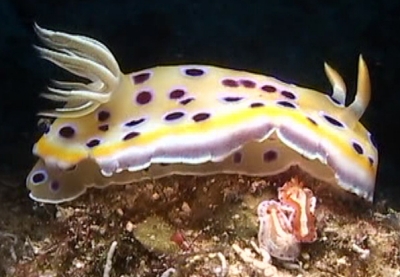
Dear Bill,
I have been all over the site, but the closest match is Glossodoris cruenta. Though the colouring is off and so is the placing of the dots on the mantle. I am sorry for the low quality of the pictures, but I only discovered the two small nudi's while reviewing the footage... (oops)
Locality: Gobal Island, near El Gouna, 25 meters, Egypt, Red Sea, 12 June 2007, Sand, bottom of cave inside reef. Length: 1 centimeter. Photographer: Darja Tjioe.
Darja Tjioe
tjioeke@hotmail.com
Tjioe, D.M., 2007 (Jul 4) Chromodoris geminus from the Red Sea. [Message in] Sea Slug Forum. Australian Museum, Sydney. Available from http://www.seaslugforum.net/find/20055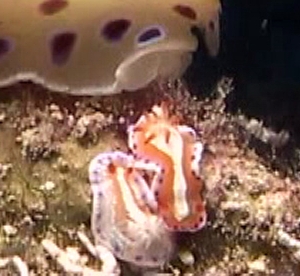
Dear Darja,
The large animal is Chromodoris geminus. It is mainly known from the western Indian Ocean and you photos show its very characteristic habit of waving all the mantle edge up and down at the same time. Its amazing how many interesting finds turn up when you look at your photos on dry land. The two little pinkish slugs are Noumea norba. Have a look at the Noumea purpurea colour group for other very similar looking species.
Best wishes,
Bill Rudman
Chromodoris geminus from Reunion Island?
May 4, 2007
From: Hugues Flodrops
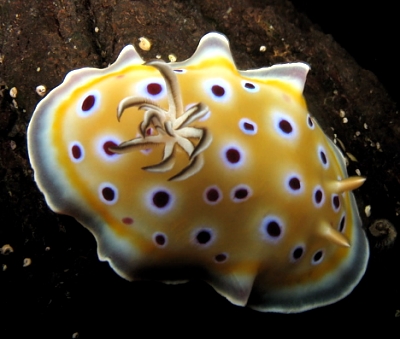
Concerning message #19851:
Dear Bill,
For a complete collection from the same pool of Etang-Salé Rocky coast; a specimen of Chromodoris geminus.
Locality: Etang-Salé, 50 cm, Reunion Island, Indian Ocean, 16 Avril 2007. Length: 40 mm . Photographer: Hugues Flodrops.
Best regards. Long life to the forum.
Hugues.
hugues.flodrops@wanadoo.fr
Flodrops, H., 2007 (May 4) Chromodoris geminus from Reunion Island?. [Message in] Sea Slug Forum. Australian Museum, Sydney. Available from http://www.seaslugforum.net/find/19863Dear Hugues,
Thanks for this record from Reunion. The is no doubt about the identity of this spectacular species.
Best wishes,
Bill Rudman
Chromodoris geminus from Bali
February 8, 2007
From: Mike Krampf
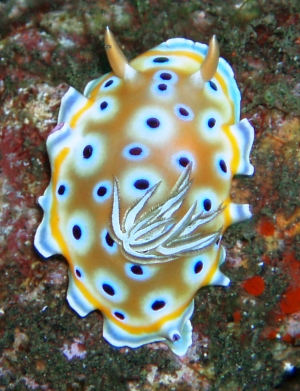
Dear Bill
I didn't see a posting on the Forum on this species from Bali so thought I'd share it with you. I believe this to be a Chromodoris geminus.
Locality: Tulamben, 30 ft, Bali, Indonesia, Java Sea, 7 October 2006, Rocky/sandy bottom. Length: 3 cm. Photographer: Mike Krampf.
Mike
mtkrampf@yahoo.com
Krampf, M., 2007 (Feb 8) Chromodoris geminus from Bali. [Message in] Sea Slug Forum. Australian Museum, Sydney. Available from http://www.seaslugforum.net/find/18902Thanks Mike,
It's nice to fill another gap in the distribution of this species. As you will see from the Fact Sheet, there are a number of other species with similar colour patterns, so it would be good to have a precise idea species of the geographic range of each species to see which have overlapping ranges.
Best wishes,
Bill Rudman
Re: Chromodoris geminus from Thailand
November 29, 2006
From: Asther Lau
Concerning message #18575:
Hello Bill,
Now that you mentioned the dark blue sponge, I see from Erwin's photo on message #3658, there were similar dark blue sponges with 2 Chromodoris geminus. They seem to be eating?
Asther Lau
asther@astherlau.com
Lau, A.M., 2006 (Nov 29) Re: Chromodoris geminus from Thailand. [Message in] Sea Slug Forum. Australian Museum, Sydney. Available from http://www.seaslugforum.net/find/18689Dear Asther,
Yes I had looked a that photo, but I think its a bit risky to use such a dark shadow as a positive record -although I agree it is probably this blue sponge
Best wishes,
Bill Rudman
Re: Chromodoris geminus from Thailand
November 28, 2006
From: Kamal El Tawil
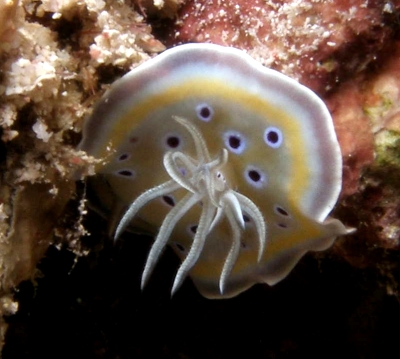
Concerning message #18514:
Dear Bill:
I am attaching a picture of C. geminus from Egypt, clearly showing the white, grey, white and yellow bands. maybe it would be of help to the forum.
Locality: Daedalus reef, 20 metres, Egypt, Red Sea, 11 September 2006. Length: 3 cms. Photographer: Kamal el Tawil.
Best regards,
Kamal
www.coralworld.net
kamal@coralworld.net
El Tawil, K., 2006 (Nov 28) Re: Chromodoris geminus from Thailand. [Message in] Sea Slug Forum. Australian Museum, Sydney. Available from http://www.seaslugforum.net/find/18579Thanks Kamal,
Best wishes,
Bill Rudman
Re: Chromodoris geminus from Thailand
November 28, 2006
From: Asther Lau
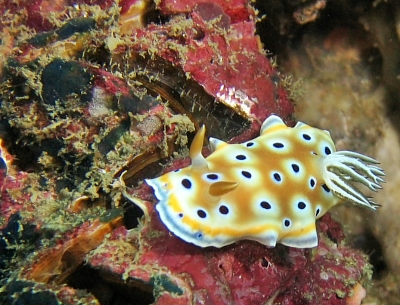
Concerning message #18514:
Hello Bill!
Thank you for the reply & confirmation. Attached herewith is another Chromodoris geminus found on the same dive few minutes after the 1st one. As you can see from the photo [lower right], nearby was a Chromodoris annulata.
Locality: Bida Nok Rock, Phi Phi Island, Approx. 10 metres, Phuket, Thailand, Andaman Sea, 4th Jan 2006, Wall covered with softcorals & silt.. Length: About 5 cm. Photographer: Asther M. Lau.
Regards,
Asther
asther@astherlau.com
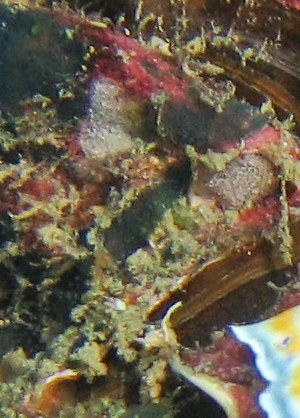
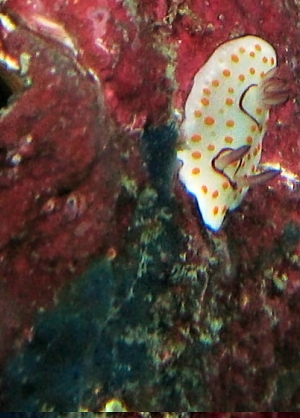
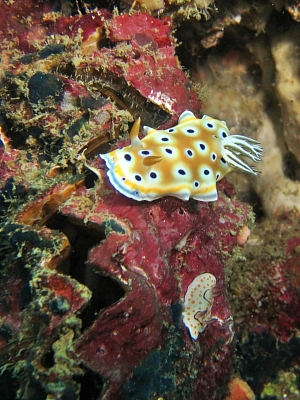
Dear Asther,
As well as posting your whole photo I have also posted some enlargements to show patches of a rather interesting dull blue sponge. When I see two chromodorids together like this my first thought is why are the both in the same spot? I know chance is the easiest answer, but it is also worth checking for other reasons.
Then I noticed that all over the oyster they are crawling on there are patches of a blue sponge. I am not sure if these patches are individual colonies or the remains of a large colony which is being systematically eaten by these two nudibranchs. Interestingly, we do not know what sponges these two species of Chromodoris feed on but their closest relatives feed either on Chelonaplysilla violacea or an unidentified dark blue sponge. I can't be sure from your photo, but I wouldn't mind betting that this dull dark blue sponge is the food of these chromodorids. It is certainly worth adding to your list of things to look out for.
Best wishes,
Bill Rudman
Chromodoris geminus from Thailand
November 23, 2006
From: Asther Lau
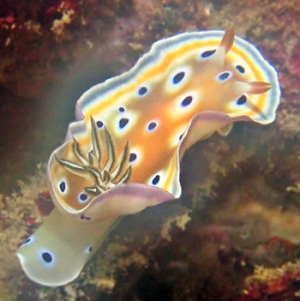
Concerning message #1441:
Hello Bill,
After studying the photos I took of this nudibranch, I'm debating whether it is Chromodoris geminus or Chromodoris tritos.
Locality: Bida Nok Rock, Phi Phi Island, Approx. 16 metres, Phuket, Thailand, Andaman Sea, 4th Jan 2006, Wall covered with softcorals & silt.. Length: About 5cm. Photographer: Asther M. Lau.
My camera happened to fog when I found the little crawler. Due to this, I can't be sure it the spots are surrounded by blue color or not. Please help confirm the ID of the nudibranch. Thank you for your kind attention.
Regards,
Asther
asther@astherlau.com
Lau, A, 2006 (Nov 23) Chromodoris geminus from Thailand. [Message in] Sea Slug Forum. Australian Museum, Sydney. Available from http://www.seaslugforum.net/find/18514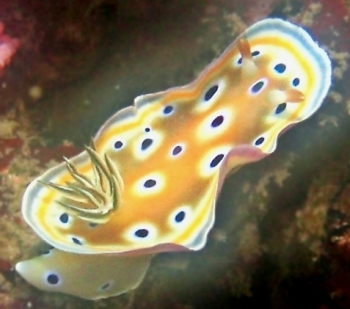
Dear Asther,
As you'll see on the C. tritos Fact Sheet, these two species and Chromodoris kuniei, can be separated by mantle colour, and in particular the colour bands around the mantle edge. Your animal with the white, grey, white and yellow bands is clearly C. geminus. It is nice to find yet another species, previously thought restricted to the Western Indian ocean, to occur as far east as Thailand. This fits with the record we have on the Forum of this species from Christmas Island.
Best wishes,
Bill Rudman
Flapping Chromodoris geminus from Pemba Islands
March 2, 2006
From: Pasquale Pascullo
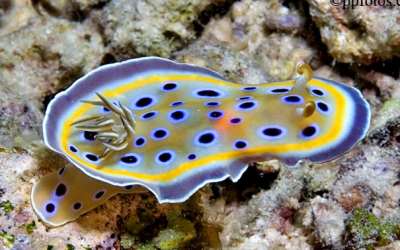
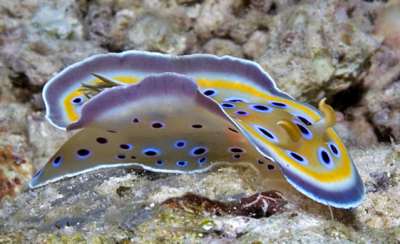
Is this Chromodoris geminus? I have some great people helping me id some subjects, but seeing other pictures confuses me when researching - some are so close to it (C. kuniei?)
What is the behavior showing us with the flapping?
Locality: Pemba Islands , +/- 11meters, EastCoast Tanzania, west Indian Ocean, Feb 08 '06, rough rocky reef. Length: 2inches. Photographer: Pasquale Pascullo.
Thanks again for your time and work here Bill.
Pasquale Pascullo
www.ppfotos.com
pp@ppfotos.com
Pascullo, P., 2006 (Mar 2) Flapping Chromodoris geminus from Pemba Islands. [Message in] Sea Slug Forum. Australian Museum, Sydney. Available from http://www.seaslugforum.net/find/15993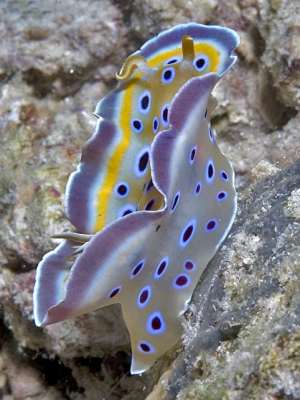
Dear Pat,
Thanks for these photos showing the mantle flapping behaviour of this species. This is one of the most spectacular of a group which flap their mantle as they crawl along. They have glands around the mantle edge which store distasteful chemicals they store from their sponge food. It is possible that flapping the mantle edge like this draws possible fish predators to the most distasteful parts of their body. Once the fish have had a few nibbles perhaps they learn to give not only the colour pattern but also animals with a flapping mantle a wide berth in the future. I must say this is only a hypothesis. We still have much to learn about them.
C. geminus and C. kuniei are very similar in colour. I called this species C. geminus [geminus = twin] precisely because they look so alike.
Best wishes,
Bill Rudman
Chromodoris geminus from the Egyptian Red Sea
January 3, 2005
From: Michael Mrutzek
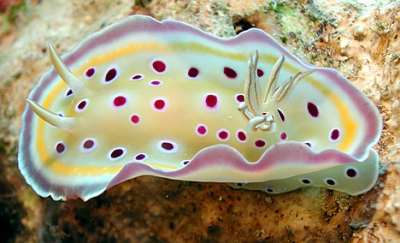
Hello Bill
Here is a photo of Chromodoris geminus for your Forum
Locality: Reef at Hurghada, Egypt, Red Sea. Depth: 40 meters. Length: 60 mm. June 2004. Photographer: M. Mrutzek
Michael Mrutzel
Michael@meeresaquaristik.de
Mrutzek, M., 2005 (Jan 3) Chromodoris geminus from the Egyptian Red Sea. [Message in] Sea Slug Forum. Australian Museum, Sydney. Available from http://www.seaslugforum.net/find/12878Thanks Michael,
A record of this species from the Red Sea is a useful additional bit of information. It is known from many parts of the Indian Ocean, but there are less than 10 records of it in the scientific literature so every one counts
Best wishes,
Bill Rudman
Chromodoris geminus from Thailand
January 23, 2003
From: Mary Lojkine
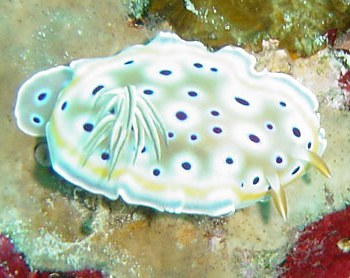
This photo was taken at the Similan Islands in the Andaman Sea, west of Thailand, at a depth of about 12m. The site consisted of coral bommies separated by white sand. The photograph was taken on 9 Jan 2003. The dive site was Batfish Bend, near Koh Miang.
I think it may be Chromodoris aspersa, but I don't see the purple outer margin in any of the photos on your site.
Best wishes,
Mary
mary@lojkine.com
Lojkine, M., 2003 (Jan 23) Chromodoris geminus from Thailand. [Message in] Sea Slug Forum. Australian Museum, Sydney. Available from http://www.seaslugforum.net/find/8910Dear Mary,
By chance we have recently had a message from Danny Van Belle with some photos of this species from the Similan Ids. It is Chromodoris geminus.
Best wishes,
Bill Rudman
Chromodoris geminus from Similan Islands
January 15, 2003
From: Danny Van Belle
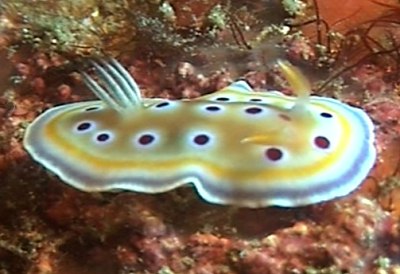
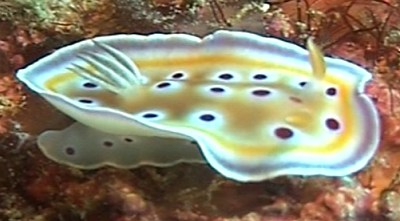
Hi Bill,
Some pictures of Chromodoris geminus
Divesite: Rocky point at Koh Bangu, Similan islands, Thailand. Depth: 20m
Cheers,
Danny
dannyvb@hotmail.com
Van Belle, D., 2003 (Jan 15) Chromodoris geminus from Similan Islands. [Message in] Sea Slug Forum. Australian Museum, Sydney. Available from http://www.seaslugforum.net/find/8861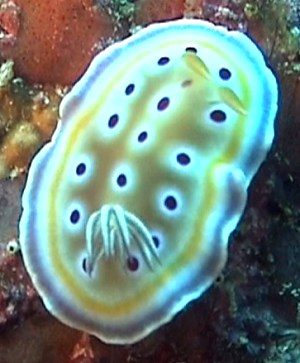
Thanks Danny,
The distinctive purple and yellow mantle bands make this easy to separate from the similarly coloured species discussed on the Fact Sheet. This species is found throughout the Indian Ocean.
Best wishes,
Bill Rudman
Chromodoris geminus from Christmas Island
April 28, 2002
From: Bill Rudman


Here is some information and photos on Chromodoris geminus from John Hicks' Christmas Island, Indian Ocean collections.
PHOTOS:
AM C131049, 3 August 1981, Cantilever, 10 m, Christmas Is., Indian Ocean. 35 mm long alive. Photo: John Hicks
This well illustrates the interesting faunal assemblage at Christmas Island, as yesterday I posted a record of C. kuniei from here. C. kuniei and C. geminus are considered a pair of sibling species, the former restricted to the Western Pacific and the latter to the Indian Ocean.
Best wishes,
Bill Rudman
Chromodoris geminus from the Maldives
November 27, 2001
From: Peter Steggle
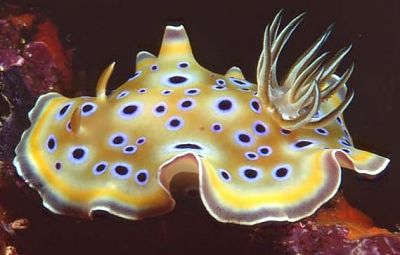
Hi,
I found this Nudibranch on a wall dive in Ari Atoll, Maldives, during October 2001, at a depth of about 20m. The wall was completely covered in a mixture of Hydroids, Sponges and Corals (both soft and hard). I have tried to identify it from several books and your site but without any success.
Peter Steggle
Chichester
England
psteggle@aol.com
Steggle, P., 2001 (Nov 27) Chromodoris geminus from the Maldives. [Message in] Sea Slug Forum. Australian Museum, Sydney. Available from http://www.seaslugforum.net/find/5713Dear Peter,
This is Chromodoris geminus which appears to be the Indian Ocean member of a group of similarly coloured species, including the western Pacific species C. kuniei and species C. tritos, also from the Indian Ocean.
Best wishes,
Bill Rudman
Chromodoris geminus from the Maldives
January 30, 2001
From: Erwin Koehler
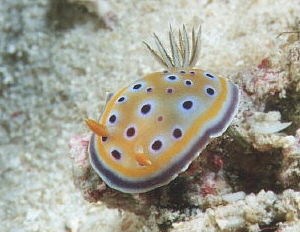
Dear Bill,
Here is Chromodoris geminus from the Maldive Islands, South Male Atoll, Kandooma Island, divesite "Kandooma Out", depth 19m,
size 24mm, Sept. 17, 2000. I think it looks different from Chromodoris tritos.
Erwin
Medslugs.Koehler@t-online.de
Koehler, E., 2001 (Jan 30) Chromodoris geminus from the Maldives. [Message in] Sea Slug Forum. Australian Museum, Sydney. Available from http://www.seaslugforum.net/find/3657Thanks Erwin,
Bill Rudman
Chromodoris geminus from Thailand
January 30, 2001
From: Erwin Koehler
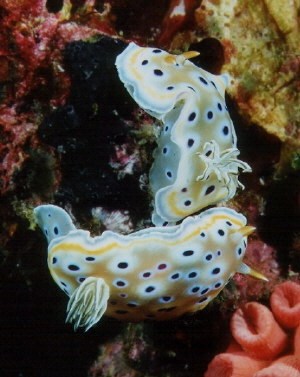
Dear Bill,
Here are 2 Chromodoris geminus from Thailand, divesite "Hin Daeng", depth 15m, size 41 + 44mm, Dec. 28, 2000.
Erwin
Medslugs.Koehler@t-online.de
Koehler, E., 2001 (Jan 30) Chromodoris geminus from Thailand. [Message in] Sea Slug Forum. Australian Museum, Sydney. Available from http://www.seaslugforum.net/find/3658Thanks Erwin,
It's good to get more records away from the western Indian Ocean.
Bill Rudman
Chromodoris geminus from South Africa
April 22, 2000
From: Valda Fraser
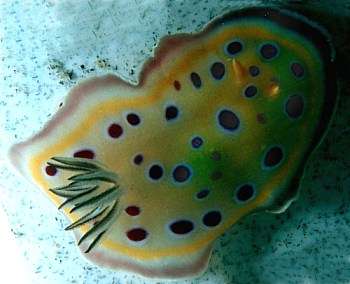
Dear Bill
I was pleased to find Chromodoris geminus for the first time. It really is a beautiful nudibranch.
Locality: South coast KwaZulu-Natal, SOUTH AFRICA Park Rynie - 35m
Date: April 2000
Size: 40mm
Regards
Valda Fraser
iti04937@mweb.co.za
Fraser, V., 2000 (Apr 22) Chromodoris geminus from South Africa. [Message in] Sea Slug Forum. Australian Museum, Sydney. Available from http://www.seaslugforum.net/find/2305Dear Valda,
It is a good find. Did you see it flapping all its mantle edge up and down at the same time? It is characteristic of this and only a few other species. It would be good to know if you did, as you might then be able to compare it with the behaviour of Chromodoris cf. geminus which I am pretty sure now is a distinct species.
Best wishes,
Bill Rudman.
